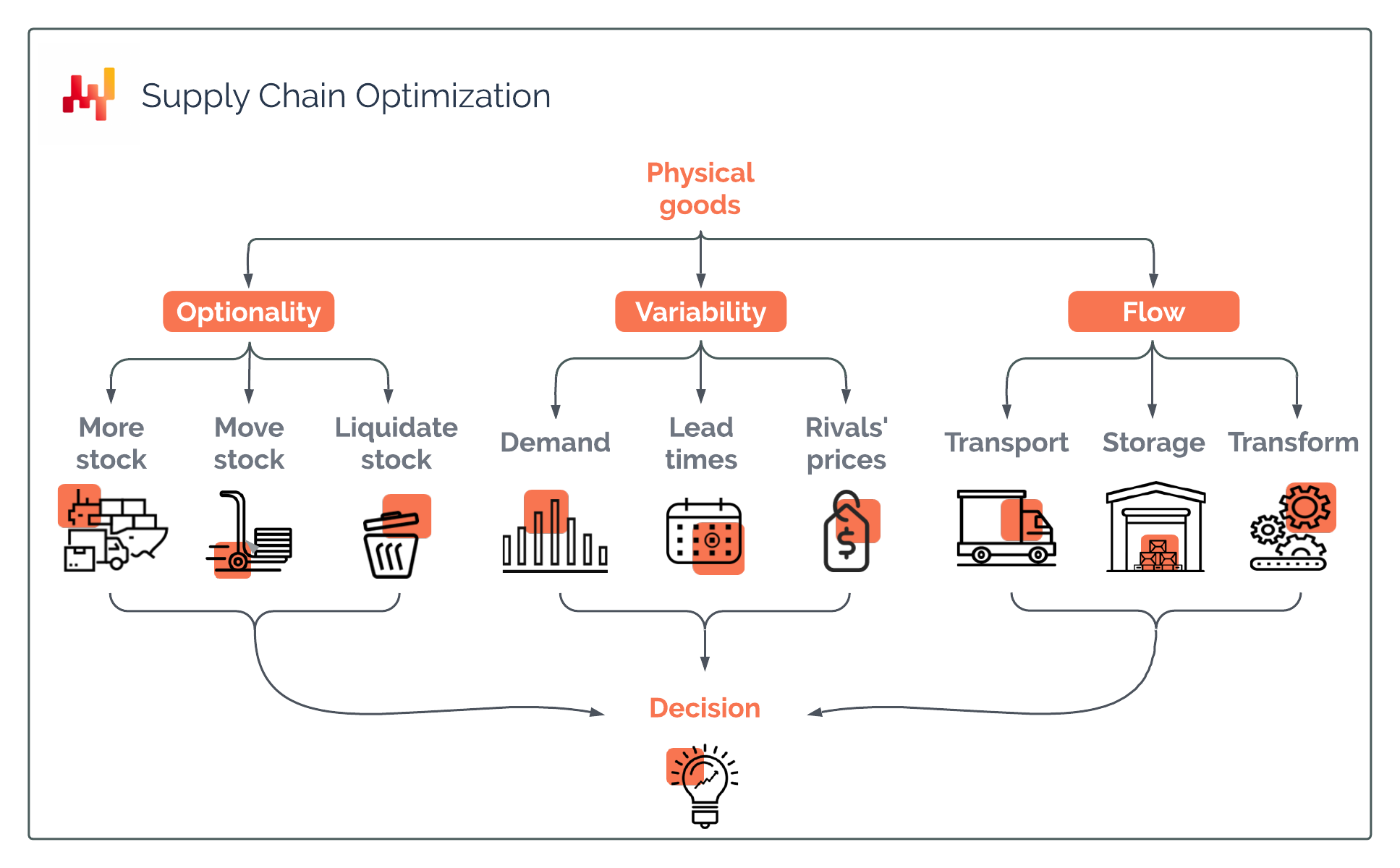An optimized supply chain automates repetitive, mundane decisions, thus allowing management to redirect bandwidth - and resources - to more pressing matters. Before one can optimize, however, one must first comprehend, and supply chain is a vast and exceedingly complex network. As such, mastering the optionality, variability and flow within one’s supply chain is paramount, and should be approached from a purely financial perspective.
Watch the Lecture

Definition of Supply Chain
At its core, the Lokad vision of supply chain (SC) is mastering the optionality one encounters as a result of the variability inherent to the flow of goods. Each element of this definition requires a degree of unpacking.
Optionality denotes all the possible decisions one could take in a supply chain, which amount to hundreds if not thousands of possibilities. These choices range from the seemingly simple (adding more stock in a certain location) to the logistically complex (launching an entirely new assortment of products). The former are routine and mundane; the latter strategic and deserving of increased bandwidth. An optimized supply chain automates mundane decisions, thus freeing managerial resources for tackling the more challenging, strategic ones.
Variability can be understood as the uncertainty and uncontrollability of the future. Though we can attempt to forecast market demand, we cannot control it. Similarly, we cannot wholly control lead times or the actions of our competitors. Supply chains are vulnerable to countless sources of variability, most of which we cannot really control and all of which we must fully consider.
Finally,
flow refers to the movement of physical goods. For businesses, there is constant movement of materials, products, inventories and other goods, all with their own logistical constraints (modes of transport, storage, etc.), each presenting the supply chain practitioner with something new to consider. Overall, supply chains must contend with optionality, variability and flow if the business is to improve, and each one of these concepts will be scrutinized through the lens of optimization.
Limitations of “Mainstream Supply Chain” Theories
A key part of Lokad’s vision is the premium we place on falsifiability, and it is here that Lokad’s vision diverges from mainstream supply chain (MSC) theories.
Falsifiability is the capacity for a system or idea to be tested and proven wrong. Though most MSC theories are well-researched and predicated upon sound mathematical models, they are insulated against falsifiability. Researchers often cherry-pick scenarios that demonstrate precisely what they sought to prove. Simply, the examples one finds in foundational textbooks do not properly account for the variability and uncertainty of running an actual supply chain. These theories essentially exist in an academic vacuum.
An example of this is safety stock - the level of extra stock a company keeps on hand to prevent the possibility of a stock-out event. Historically, this level is calculated using formulas that do not capture the full extent of demand uncertainty and overall randomness. As a result, the gap between academic theory and real-world supply chains is often unbridgeable. On the other end of this spectrum, Lokad’s aim is
reproducibility at scale, which is only possible through the process of testing and revising everything, including our successes. If we cannot quantify the parameters of a success, it is not a success. Everything must be understandable and falsifiable.
Understanding Supply Chain Optimization
At Lokad, SC optimization is a practical measure of monetary impact. For example, we measure the success of our forecasts in
reduced dollars of error, which is to say
the amount of financial loss that was avoided. This is completely contrary to MSC theories, where resources (including time, effort, money, and mental bandwidth) are dedicated to the pursuit of
increased forecast accuracy, regardless of dollars of error.
This is a crucial point: Lokad’s stance is not that increased forecast accuracy is worthless. Rather, it is useless if it does not translate into dollars saved. If a forecast is 10% more accurate but results in 20% less profit, it is not an optimized forecast in terms of
reduced dollars of error. At the end of the day, the purpose of business is to make money, or at the very least, not waste it. This is the area of SC where
software-based intelligence is deployed to yield
reduced dollars of error through optimized choices, thus freeing management to focus on other important business matters.
In short, Lokad’s position is that SCs do not operate in vacuums, thus one must look
outwardly to solve problems of uncertainty and chance, utilizing all the tools at one’s disposal, especially software.

